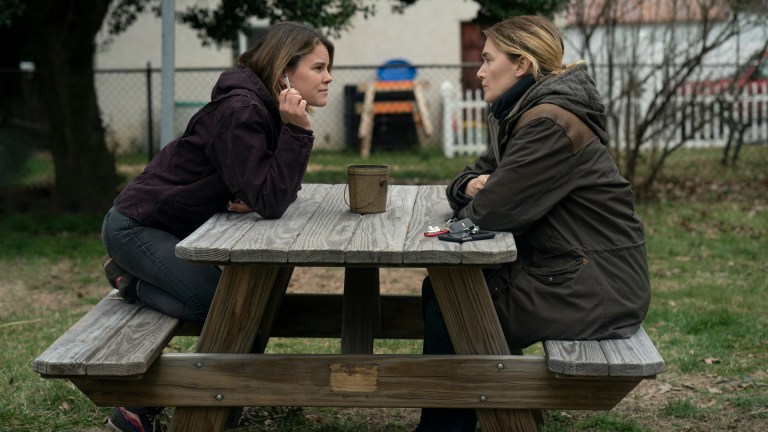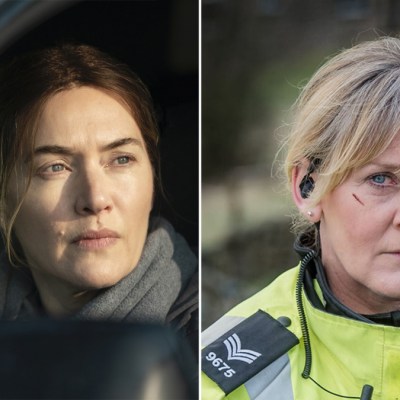Mare of Easttown Is a Story of Addiction
The specter of addiction looms large over Mare of Easttown from missing drug-users to the Sheehan family's generational trauma.

This article contains spoilers for Mare of Easttown through episode 5.
On its surface, Mare of Easttown is a murder mystery: Who killed poor, sweet, Erin McMenamin? By the time the credits roll on the final episode, we will almost certainly have that answer (unless we don’t). Yet, the connective tissue of the series goes much deeper than a simple whodunnit. The threads that bind the citizens of Easttown together are woven through with unspoken pain, loss, and tightly held secrets.
Of course, Easttown itself is meant to be a primary character in the show. Ever since the endless “squee-ing” over New York City as the fifth member of the Sex in the City posse, the city-as-character trope has made its way into many a prestige HBO series. However, instead of the effervescent heartbeat of spontaneity that NYC lent to SATC, Easttown invokes obstinate loyalty and stagnation. And, while the oppressive slog of existing in Easttown certainly looms large in the series, it’s the grimy patina of addiction that colors every single frame of its story.
Much like the malicious It in Stephen King’s popular novel, addiction is an evil force. It wends its way through communities, dosing everyone along the way with a bit of hopelessness and despair. Addiction doesn’t just impact the person struggling with addiction; it’s an insidious cancer that spreads throughout families and communities, fueled by apathy, denial, and repressed trauma.
While we see many characters in the town struggle with addiction in various ways, Mare (Kate Winslet) is virtually surrounded by it. First, Mare’s job as a detective sergeant requires her to often navigate substance-related issues. Early on in the series, she tells the spacey Betty Caroll (Phyllis Somerville) that she investigates all the “really bad shit” that goes on in town, including burglaries and overdoses (pronounced with those exaggerated Delco ‘o’s!). This is a town that has been hit hard by the opioid crisis, and part of Mare’s job has shifted to dealing with all of the horrors that come along with that waking nightmare.
On the family front, we know that Mare’s son Kevin had a troubled past. Throughout the series, we’ve been learning more and more about Kevin’s life, about both his impact on Mare as a person and a mother and her impact on his development. He had been diagnosed with several disorders in his childhood, which led to over-medication, which led to substance misuse and eventually suicide in his early 20’s.
This is all very heavy stuff. And it only gets heavier. In therapy, Mare reveals that her father also suffered from depression and that he had committed suicide when she was only thirteen years old. She also recalls suffering from bouts of depression, but states that she didn’t want to burden anyone else with her problems when she was experiencing them. So, instead, she drinks.
Mare might not realize that she is self-medicating with every casual swig from her emerald Rolling Rock bottles or every violent tug from her vape pen, but she definitely is. She feels that she was unable to help her son or her father, and now she is trying to forget her feelings of crushing guilt, however temporarily. And she is truly haunted by the fact that a similar fate may be waiting for her adorable little nugget of a grandson, Drew.
Ultimately Mare misuses alcohol in an attempt to help her cope with her job, much of which is dealing with substance-related crime, all while reeling from the loss of her son who also struggled with addiction. It’s an addiction lasagna all the way down. Weighted down by repressed emotion, Mare chooses to numb herself out instead of facing the pain head on. In doing so, she unknowingly perpetuates the cycle of intergenerational trauma all while desperately wanting to break free from its grasp.
This. This is what addiction wants. This is how it wins. By keeping people numb and trapped, these maladaptive coping mechanisms can pass down through the generations, and misery can continue unbroken. And there is so much misery in Easttown. Mare is certainly not alone in her choice to self medicate rather than reach out for help, but it’s also apparent that there isn’t much help to be had in the area. Mare’s encounter with Freddie (Dominique Johnson) in the first episode of the series illustrates as much.
When Mare chases down Freddie for burglarizing his sister Beth’s house, she sticks him in a cop car and runs down his options. His heat has been turned off for lack of payment, so he can either stay in his freezing house or he can stay at the local shelter run by the church. After some convincing by Mare, he opts for the shelter. She directs the newbie officer driving the car to bring Freddie to the hospital to have a wound looked at, then bring him to the shelter, and then call the power company. Whew. That’s quite a lot for an officer to take responsibility for, but the young man agrees without blinking an eye.
Mare’s directive to the officer takes mere seconds, but it encapsulates why police funds desperately need to be redirected to agencies that have the capacity to truly help people in Freddie’s situation. As a part of the police department, Mare is doing the best she can with what she has, but she is unable to take proactive steps to help people like Freddie recover. She can only take reactive steps after a crime has been committed.
Faced with a scarcity of well-funded and competent community supports, even well meaning authority figures like Mare can – and do – become desensitized and inured to the humanity of people struggling with addiction. It’s clear from the jump that Mare had mostly written off Katie Bailey, the Original Missing Girl™, as simply an addict who was probably dead at the bottom of the Delaware River. But, shocker, Mare was wrong. Katie has been alive the entire time, as the end of episode 4 reveals.
Even though she had issues with addiction, Katie was certainly worthy of saving. However, the way that American society has conceptualized addiction is that it is a moral failing on the part of the individual, and therefore these individuals are responsible to deal with their own respective consequences and recoveries. We now know that this is dead wrong. The continued scourge of addiction is a policy failure that treats substance misuse as a criminal justice issue instead of a societal one. Therefore there are no readily available resources for people to access even when they do want to seek help. This is likely why Katie was engaging in risky behaviors to obtain money for drugs, and why she was in a vulnerable position to be exploited and kidnapped by a monster masquerading as a man.
On a different side of the spectrum, we can also look to Drew’s mother Carrie as a prime example of this problem. At one point, Mare visits Carrie at her halfway house. It’s a small, dilapidated structure. A new admit just arrived carrying bed bugs. According to Carrie, the agency is called “Rebirth”, implying that the residents were “all dead before we got here.” To the system, individuals who suffer from addiction problems don’t actually count as people until they get clean and sober. Carrie, like so many others, is managing to succeed despite the system, not because of it. (Also despite a scorched earth, drug planting campaign from Mare, but that’s a whole other story.)
Carrie. Katie. Mare. Freddie. There isn’t a single character in Easttown who has been untouched by addiction. It is a complex evil that encourages people to stay quiet out of pride, guilt, and shame even when they need help and support. It is an evil that often goes unnamed until it is too late. And it will continue to infect the shadows of towns both small and large unless we bring it into the light.
Mare of Easttown airs Sundays at 10 p.m. ET on HBO.


